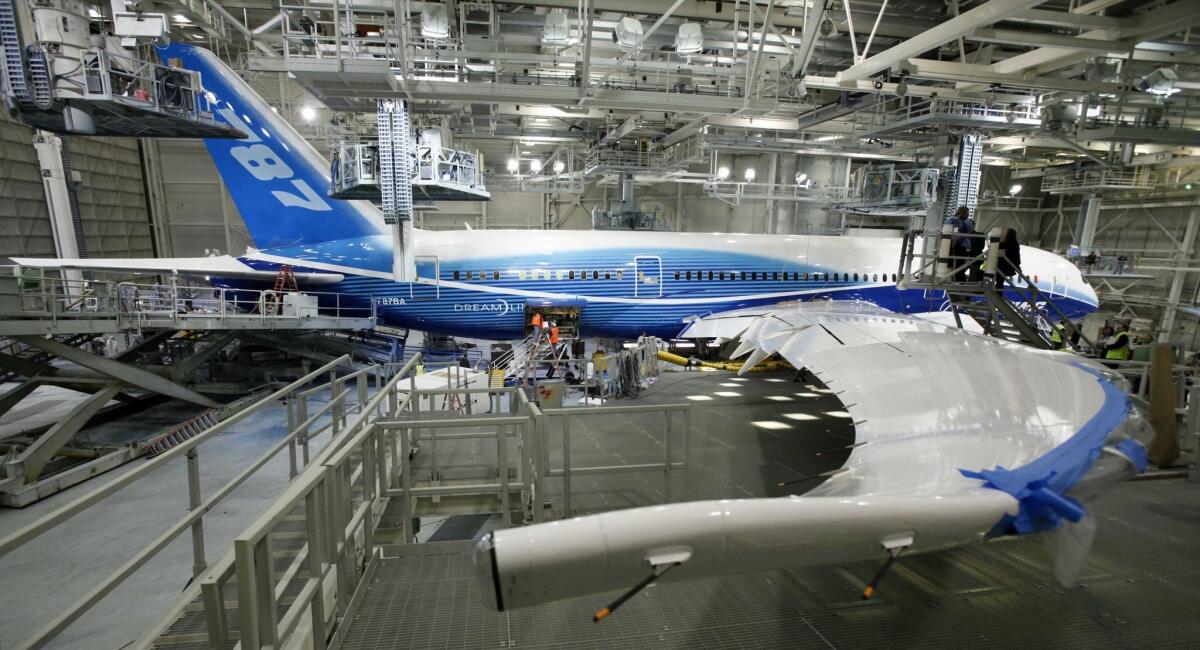Boeing inspecting Dreamliner wings for cracks; possible delivery delays

Boeing Co. has notified airlines that a change in a supplier’s manufacturing process may have resulted in hairline cracks on the wings of about 40 of its yet-to-be-delivered 787 Dreamliners.
Japan’s Mitsubishi Heavy Industries Ltd. told Boeing there was a problem related to fasteners on the 787’s carbon fiber composite wing.
Boeing, which has delivered 123 of the planes, said the problem may be present in a limited number of airplanes still in production, but none of its in-service fleet is involved. The company expects delays in deliveries. However, its 2014 delivery guidance of 110 jets will not be impacted.
PHOTOS: Inside airlines’ Boeing 787 Dreamliners
The Chicago aerospace giant said the affected areas are small. It expects to address the issue within two weeks.
“We understand the issue, what must be done to correct it, and are completing inspections of potentially affected airplanes,” Boeing spokesman Doug Alder said. “We are addressing affected airplanes as required.”
The problem, which was first reported by the Wall Street Journal, is the latest in a string of issues that company has faced with its flagship jet.
Although the commercial aircraft manufacturing industry is notoriously plagued by nagging issues, the confluence of problems on the 787 is unprecedented for Boeing. The list includes faulty parts from suppliers, design flaws and safety concerns from aviation authorities.
FULL COVERAGE: Boeing’s troubled Dreamliner
Major parts for the plane are assembled all over the world and then shipped to two plants in Everett, Wash. and Charleston, S.C., where they are “snapped together.”
The design has proved difficult because of the widespread supply chain, but also because it is the first large passenger jet to have more than half its structure made of a high-tech blend of lightweight composite material instead of aluminum.
Boeing has promised airlines that the use of composites and a newly developed engine will result in a plane that burns 20% less fuel than jetliners of a similar size. Airlines have been attracted to those savings and have ordered more than 1,000 of the planes.
The 787 entered service for the first time in October 2011 for the Japanese airline All Nippon Airways.
PHOTOS: Boeing 787 Dreamliner takes flight
Problems cropped up soon and culminated in January 2013 when the FAA grounded all 787s for nearly four months after lithium-cobalt batteries on two planes overheated, with one catching fire.
The fleet returned to service that April after the FAA required airlines flying 787s to install containment and venting systems for the batteries.
Then that July, a fire erupted on an empty 787 while it was parked at London’s Heathrow Airport. The blaze was eventually traced to a device, called an emergency locater transmitter, which the FAA required airlines to inspect or remove.
Earlier this year, Japan Airlines discovered what appeared to be white smoke during routine maintenance work thought to be related to an overheating battery.
ALSO:
For F/A-18 Super Hornet, the end may be on the horizon
Engineer accused of trying to send F-35 fighter jet papers to Iran
Lockheed and AeroVironment sign agreement on drone development
More to Read
Inside the business of entertainment
The Wide Shot brings you news, analysis and insights on everything from streaming wars to production — and what it all means for the future.
You may occasionally receive promotional content from the Los Angeles Times.











